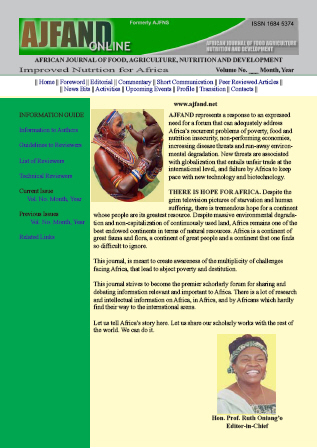
|
African Journal of Food, Agriculture, Nutrition and Development
Rural Outreach Program
ISSN: 1684-5358
EISSN: 1684-5358
Vol. 10, No. 2, 2010, pp. 2152-2165
|
 Bioline Code: nd10018
Bioline Code: nd10018
Full paper language: English
Document type: Research Article
Document available free of charge
|
|
|
African Journal of Food, Agriculture, Nutrition and Development, Vol. 10, No. 2, 2010, pp. 2152-2165
| en |
Determination of Bisphenol A Diglycidyl Ether Content in Foods from Lacquered Cans
Biego, G. H. M.; Yao, K. D.; Ezoua, P. & Kouadio, L. P.
Abstract
Canned foods are increasingly used in food packaging. Packaging serves mainly to
preserve, inform and sell foodstuffs. In order to avoid migration issues of chemical
compounds from tin cans to foods, covering internal surface of the tin cans with
epoxyphenolic and organosol resins is widespread. However, monomers like
Bisphenol A Diglycidyl Ether (BADGE), number among the constituents of these
resins capable of migrating to foods. This chemical compound (BADGE) is highly
toxic not only for the immune, reproductive and hepatic systems but also for
biomolecules such as DNA, nucleic acids, proteins, and hormones. Simulation tests of
migration can be used to assess the significance of BADGE migration. For this study,
the migration and degradation tests were realized with metallic sheets and cans
lacquered with epoxyphenolic or organosol resins. BADGE concentrations were
determined by High Performance Liquid Chromatography (HPLC) using a Hewlett
Packard HPLC chromatograph 1050 serial equipped with an injection valve of 50 μL,
a Hewlett Packard spectrophotometric UV detector serial 1050 and a Hewlett Packard
integrator serial 3396. BADGE detections were made at 275 nm and compounds were
separated on a LiChrospher 100 RP-18 (Merck, 250 x 4 mm I.D., 5 μm) column
protected by a guard LiChrospher 100 RP-18 (Merk, 5 μm) column. The mobile phase
was a mixture of methanol, water, and dichloromethane (CH3OH-H2O-CH2Cl2)
according to 50%-20%-30% proportion of solvents and the flow was 1 mL.min-1. The
content in BADGE ranged from 3 to 37 μg.L-1. These concentrations were only
slightly influenced by the storage conditions (duration and temperature). The highest
concentrations were found in distilled water from cans analyzed just after sterilization
and the lowest concentrations in distilled water from cans stored at least one day
before analyses. BADGE degradation tests in aqueous environment provided an
explanation to the lowest concentrations of BADGE in lacquered cans. Finally, the
number of sterilization also proved to be critically important for the reduction of
BADGE content in cans.
Keywords
Epoxyphenolic resin, BADGE, can, food
|
| |
© Copyright 2010 - African Journal of Food Agriculture, Nutrition and Development.
Alternative site location: http://www.ajfand.net/
|
|
